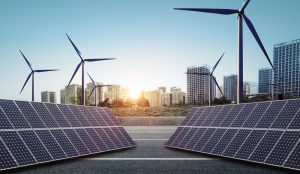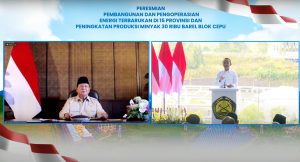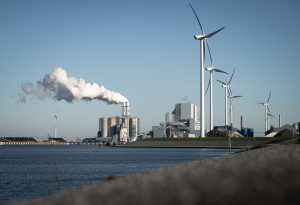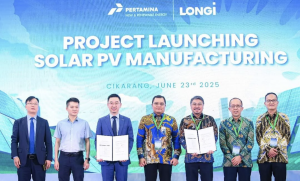by: Hartatik
Nusa Dua, Bali – So far there is a lack of transparency regarding the funding composition, the ratio of debt and grants, in the Just Energy Transition Partnership (JETP) worth USD 20 billion. Minister of Finance Sri Mulyani said that the details of this funding commitment would still be discussed with a number of related parties. The JETP scheme is funded by a combination of multilateral development banks, bilateral, as well as philanthropy, as well as grants.
“We will look at it with a detailed perspective because it has various combinations from multilateral development banks, bilateral, and also from a philanthropic perspective, grants,” said Sri Mulyani.
She said the JETP funding will later be used to accelerate the retirement of coal-fired power plants. As for which power plants will be retired early, it will be seen later whether there are PLN’s power that are ready or will privately-owned plants (Independent Power Producers/IPP) be the first to go.
However, the problem is that some power plants are still young, some are even less than 12 years old. Sri Mulyani believes that this ETM platform needs global and investor support.
To date, Indonesia has allocated USD 500 million to support this program. This support will increase to USD 4 billion and will be used to cover 2 GW of PLTU.
The Director of Electricity Engineering and Environment at the Directorate General of Electricity at the Ministry of Energy and Mineral Resources, Wanhar, confirmed that the operational period of coal-fired power plants in Indonesia will be ended. However, Wanhar said efforts to retire the coal plant cannot be done immediately at this time.
“Retirement of a coal fired power plant can only be carried out when there is certainty in network reliability, with the substitution of renewable energy generators and the installation of a transmission system. (Another thing to achieve is) certainty of implementing a fair energy transition with no negative social impacts from early retirement, affordable prices for renewable energy generators, and the availability of international financial support,” said Wanhar.
Chairman of the Association of Indonesian Electricity Producers (APLSI) Arthur Simatupang said that early retirement of coal-fired power plants must be seen from various aspects. First, the association is committed to PLN because there is a power purchase agreement. Second, from the funding side, stakeholders must coordinate in advance because there are funding agencies and project sponsors involved.
“On the other hand, from a commercial point of view, we also have to see how much energy production from the power plant has so far entered the system, because each (plant) has an output capacity that is the reliability of the national electricity system in Indonesia,” said Simatupang.
He also asked the government to detail and clarify the coal-fired power plants early retirement funding scheme through blended finance.

The debt trap
Researcher and Program Manager for Trend Asia, Andri Prasetiyo, reminded that the United States and Japan, as leaders in JETP funding negotiations, have a great interest in the energy sector in Indonesia with a long history of funding Indonesia’s dependence on oil, gas and coal.
“JETP tends to be described as a life-saving, fast-moving capital initiative, offering opportunities and a transformative approach to support partner countries in their energy transition away from coal. However, I am concerned that JETP may fail to support the most critical elements of a just transition, if it only issues debt and does not provide a sufficient portion of grants or soft financing for developing countries,” said Prasetiyo in a webinar held by Climate Tracker Asia.
According to him, the government must ensure that the funding has an adequate portion of grants or soft financing rather than commercial financing that follows the interest rate prevailing in the market. JETP funding as a climate initiative is expected to be able to help developing countries to retire these power plants, so what is needed is a matter of bigger grants, a form of responsibility for developed countries as parties that produce emissions.
Prasetiyo also highlighted the efforts of former US State Secretary John Kerry as the initiator of JETP Indonesia, who is promoting carbon funding as part of an energy transition funding scheme, especially in Indonesia. The emphasis on private funding will actually make it difficult for the energy transition efforts needed, so they tend to insert pseudo-solutions that are not transformative for the energy system and the Indonesian economy. For example, excessive support for battery-based electric car technology, hydrogen and carbon, capture, and storage/capture, utilisation, and storage (CCS/CCUS).
“And for now, they want to bring the initiative as a form of a new term called JETP, but there is no guarantee of sufficient grants. There are no financial guarantees to help developing countries move away from coal. So I’m worried that JETP is really just another type of loan that will lead to adjustments to the pressures and problems of developing countries,” added Prasetiyo.
Furthermore, he said the implementation of the JETP project in Indonesia is also overshadowed by dangerous risks and major failures in efforts to decarbonize the electricity system. This is because the government is still giving ambiguous signals in the energy transition by not setting a clear deadline for the construction of a new coal-fired power plant. In addition, the government is still trying to expand fossil gas in the power grid, so that it will hinder the development of renewable energy.
“If JETP comes in the form of new debt, it means there will be a potential loss of public funds which in the end will not have a significant impact on reducing emissions in the electricity sector to address climate change,” he said.
Prasetiyo highlighted that South Africa’s JETP funds, which were agreed at COP26 in Glasgow, Scotland, last year, were dominated by soft and commercial debt or loans, with a grant portion of less than 3%.
Director of the Center of Economic and Law Studies (Celios), Bhima Yudhistira, responded to the JETP and ETM schemes, each of which has a value of USD 20 billion and USD 250-300 million. According to him, the funding of the two schemes is a breakthrough initiative in climate change mitigation. However, there are a number of technical issues that need to be considered.
“The form of JETP is a loan, the other part will use investment from operation funding or private funding, so there needs to be transparency regarding the projects that will be funded in detail to the public,” said Yudhistira in a virtual press conference with the theme ‘Observing the G20 Summit Agenda and Energy Transition Funding’, Thursday (17/11).
Because of this, the role of public involvement is also a central issue, including learning from the experience of JETP in South Africa. Yudhistira reminded that the funds are quite large amid rising interest rates, countries having difficulty to source funding – there are around 60 percent of poor countries who are threatened to default on debt payments. Meanwhile, according to the IMF, 25 percent of developing countries experience debt repayment difficulties.
Meanwhile, Indonesia is one of the projects that has a commitment and a long way to go to be realised. “That’s why we really have to carry out surveillance together. What is the money for, what is the management like,” said Yudhistira.
IESR Executive Director, Fabby Tumiwa, assessed that the six-month deadline for preparing the investment plan for JETP funding was too long. When compared to South Africa, Indonesia has focused from the start on stopping coal-fired power plants, developing renewable energy and a compatible electric power system to achieve net zero emissions. In the JETP requirements, Indonesia must support the target of limiting peak carbon emissions in the electricity sector of 290 million tonnes in 2030. Meanwhile, emissions from the electricity sector have reached 240 million tonnes.
“This means that there needs to be an early retirement for active coal-fired power plants. Apart from that, the planned termination of the power plants, which currently has a capacity of 13.8 GW, will be replaced with renewable energy generators. It’s just a matter of where the generator is, how big and what type it is as well as the transmission development to support it,” said Tumiwa.
According to IESR’s analysis, the target of limiting carbon emissions of 290 tons is equivalent to stopping the operation of 6 GW PLTU before 2030. Furthermore, the new renewable energy mix will be 37-40 percent in the same year.
CERAH Executive Director Adhityani Putri said that JETP uses a blended finance approach, in which public financing will be mixed with private financing with the aim of producing the best possible financing terms for Indonesia. However, there is a caveat, she said, adding that there must be a sufficient amount of zero-interest grants or concessional financing to bring the interest rate of the entire individual financing package below market rates to make the scheme work and avoid the risk of a debt trap.
“Failure to meet targets and failure to meet financing requirements has serious consequences. Indonesia’s country rating and creditworthiness could be affected and this could have spillover effects on the economy. Can the country go bankrupt? The chances are very slim but there is still a risk. Therefore, it is important for us to ensure that the agreed investment plan is feasible and can meet all targets, including the renewable energy target, the coal retirement target, and the emission reduction target,” said Putri.
Part 1: JETP, funding solution or debt trap?
Banner photo: President Joko Widodo accompanied by Minister of Finance Sri Mulyani (right) and Minister of Foreign Affairs Retno Marsudi announced the funding of an international partnership for energy transition in Indonesia through the Just Energy Transition Partnership (JETP) during the closing press conference of the G20 Summit at the Bali International Convention Center, Wednesday (16/11). (Source: Hartatik)
This report is part of the G20 fellowship supported by Climate Tracker Asia.













